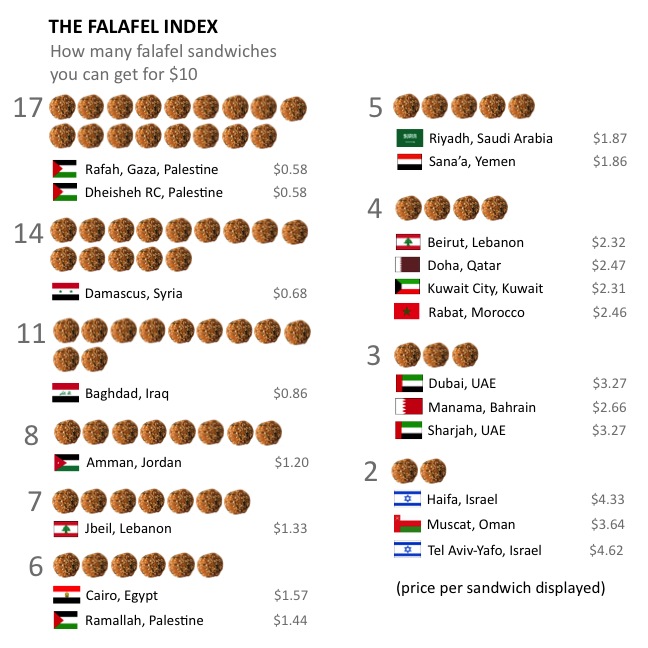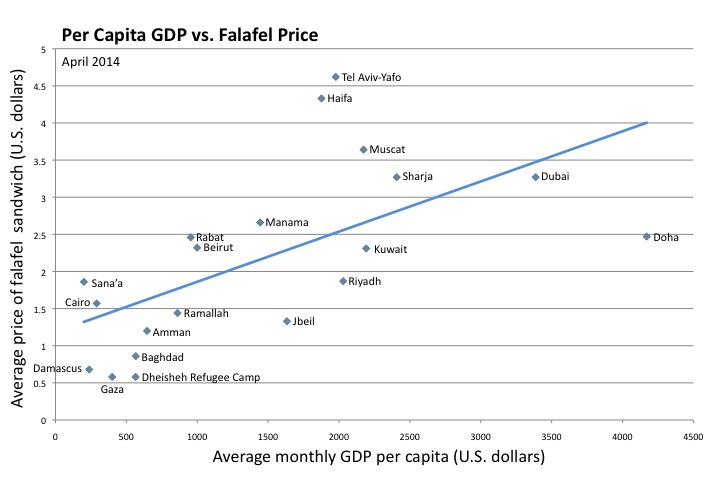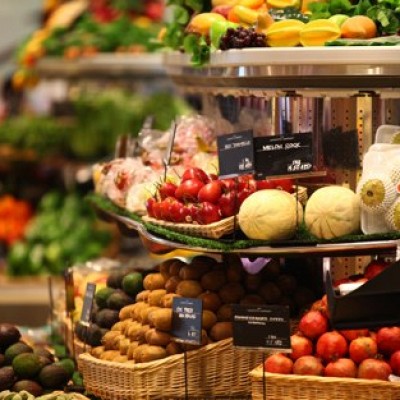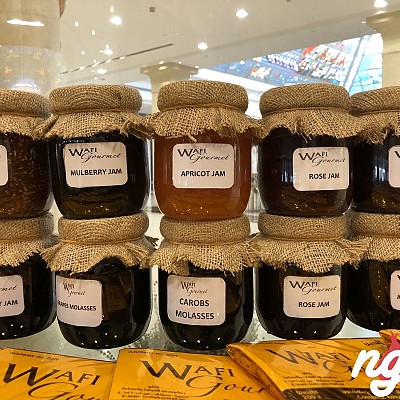The Arab Spring brought into focus the economic underpinnings of instability in the Middle East. In a region where over one in four youth is unemployed, how well people can afford a basic meal is a primary consideration.
 However, the Big Mac Index – now a golden standard for measuring purchasing power– doesn’t quite size up the region’s economic situation. This index determines the purchasing power of different currencies by comparing the prices of McDonald’s signature hamburger in various countries. But in the Middle East, eating at an international food chain, like McDonald’s, is often more expensive than local restaurants. This means that a Big Mac doesn’t represent what common folk can afford.
Second, since the Big Mac is not popular in the Middle East, it has no place in what economists call a “market basket of goods” – the goods and services that a typical consumer purchases in a month. The Big Mac, as a homogenous good, is a viable candidate for standardizing a bundle of goods across 120 countries. Yet, in the Middle East, where Big Mac’s are purchased mainly by expats, the rich, and locals who crave an occasional Western meal, the index falls short as a basis for comparison.
However, the Big Mac Index – now a golden standard for measuring purchasing power– doesn’t quite size up the region’s economic situation. This index determines the purchasing power of different currencies by comparing the prices of McDonald’s signature hamburger in various countries. But in the Middle East, eating at an international food chain, like McDonald’s, is often more expensive than local restaurants. This means that a Big Mac doesn’t represent what common folk can afford.
Second, since the Big Mac is not popular in the Middle East, it has no place in what economists call a “market basket of goods” – the goods and services that a typical consumer purchases in a month. The Big Mac, as a homogenous good, is a viable candidate for standardizing a bundle of goods across 120 countries. Yet, in the Middle East, where Big Mac’s are purchased mainly by expats, the rich, and locals who crave an occasional Western meal, the index falls short as a basis for comparison.
 For a more suitable metric, here’s some food for thought: the Falafel Index, first floated by The Majalla, an Arab magazine, in 2011. As a staple meal across the Middle East, falafel (crispy, golden balls of chickpeas) sandwiches provide a more region-specific, and thereby more accurate, basis for an index. The Falafel Index is culturally fitting, and based on the actual purchasing preferences that everyday citizens bring to the market.
Here’s yet another argument for falafelnomics: operating costs are less likely to differentiate falafel stands than McDonald’s franchises across the region. Falafel shops are usually humble franchises and serve food that is locally sourced. This mitigates the impact of transportation costs, consumer The Arab Spring brought into focus the economic underpinnings of instability in the Middle East. In a region where over one in four youth is unemployed, how well people can afford a basic meal is a primary consideration.
However, the Big Mac Index – now a golden standard for measuring purchasing power– doesn’t quite size up the region’s economic situation. This index determines the purchasing power of different currencies by comparing the prices of McDonald’s signature hamburger in various countries. But in the Middle East, eating at an international food chain, like McDonald’s, is often more expensive than local restaurants. This means that a Big Mac doesn’t represent what common folk can afford.
Second, since the Big Mac is not popular in the Middle East, it has no place in what economists call a “market basket of goods” – the goods and services that a typical consumer purchases in a month. The Big Mac, as a homogenous good, is a viable candidate for standardizing a bundle of goods across 120 countries. Yet, in the Middle East, where Big Mac’s are purchased mainly by expats, the rich, and locals who crave an occasional Western meal, the index falls short as a basis for comparison.
For a more suitable metric, here’s some food for thought: the Falafel Index, first floated by The Majalla, an Arab magazine, in 2011. As a staple meal across the Middle East, falafel (crispy, golden balls of chickpeas) sandwiches provide a more region-specific, and thereby more accurate, basis for an index. The Falafel Index is culturally fitting, and based on the actual purchasing preferences that everyday citizens bring to the market.
Here’s yet another argument for falafelnomics: operating costs are less likely to differentiate falafel stands than McDonald’s franchises across the region. Falafel shops are usually humble franchises and serve food that is locally sourced. This mitigates the impact of transportation costs, consumer preferences, and other factors that would make a Big Mac in one country cost more than in another. Also, the ingredients of a falafel sandwich are mostly the same region-wide: pillowy pita bread, crunchy tomatoes and cucumbers, silky tahini, and sweet and sour pickles.
Falafel may be the big equalizer when it comes to indexing Middle Eastern economies.
This article originally posted on Forbes...By Adam Heffez —The Washington Institute for Near East Policy... Read the rest of the story...
For a more suitable metric, here’s some food for thought: the Falafel Index, first floated by The Majalla, an Arab magazine, in 2011. As a staple meal across the Middle East, falafel (crispy, golden balls of chickpeas) sandwiches provide a more region-specific, and thereby more accurate, basis for an index. The Falafel Index is culturally fitting, and based on the actual purchasing preferences that everyday citizens bring to the market.
Here’s yet another argument for falafelnomics: operating costs are less likely to differentiate falafel stands than McDonald’s franchises across the region. Falafel shops are usually humble franchises and serve food that is locally sourced. This mitigates the impact of transportation costs, consumer The Arab Spring brought into focus the economic underpinnings of instability in the Middle East. In a region where over one in four youth is unemployed, how well people can afford a basic meal is a primary consideration.
However, the Big Mac Index – now a golden standard for measuring purchasing power– doesn’t quite size up the region’s economic situation. This index determines the purchasing power of different currencies by comparing the prices of McDonald’s signature hamburger in various countries. But in the Middle East, eating at an international food chain, like McDonald’s, is often more expensive than local restaurants. This means that a Big Mac doesn’t represent what common folk can afford.
Second, since the Big Mac is not popular in the Middle East, it has no place in what economists call a “market basket of goods” – the goods and services that a typical consumer purchases in a month. The Big Mac, as a homogenous good, is a viable candidate for standardizing a bundle of goods across 120 countries. Yet, in the Middle East, where Big Mac’s are purchased mainly by expats, the rich, and locals who crave an occasional Western meal, the index falls short as a basis for comparison.
For a more suitable metric, here’s some food for thought: the Falafel Index, first floated by The Majalla, an Arab magazine, in 2011. As a staple meal across the Middle East, falafel (crispy, golden balls of chickpeas) sandwiches provide a more region-specific, and thereby more accurate, basis for an index. The Falafel Index is culturally fitting, and based on the actual purchasing preferences that everyday citizens bring to the market.
Here’s yet another argument for falafelnomics: operating costs are less likely to differentiate falafel stands than McDonald’s franchises across the region. Falafel shops are usually humble franchises and serve food that is locally sourced. This mitigates the impact of transportation costs, consumer preferences, and other factors that would make a Big Mac in one country cost more than in another. Also, the ingredients of a falafel sandwich are mostly the same region-wide: pillowy pita bread, crunchy tomatoes and cucumbers, silky tahini, and sweet and sour pickles.
Falafel may be the big equalizer when it comes to indexing Middle Eastern economies.
This article originally posted on Forbes...By Adam Heffez —The Washington Institute for Near East Policy... Read the rest of the story...
 However, the Big Mac Index – now a golden standard for measuring purchasing power– doesn’t quite size up the region’s economic situation. This index determines the purchasing power of different currencies by comparing the prices of McDonald’s signature hamburger in various countries. But in the Middle East, eating at an international food chain, like McDonald’s, is often more expensive than local restaurants. This means that a Big Mac doesn’t represent what common folk can afford.
Second, since the Big Mac is not popular in the Middle East, it has no place in what economists call a “market basket of goods” – the goods and services that a typical consumer purchases in a month. The Big Mac, as a homogenous good, is a viable candidate for standardizing a bundle of goods across 120 countries. Yet, in the Middle East, where Big Mac’s are purchased mainly by expats, the rich, and locals who crave an occasional Western meal, the index falls short as a basis for comparison.
However, the Big Mac Index – now a golden standard for measuring purchasing power– doesn’t quite size up the region’s economic situation. This index determines the purchasing power of different currencies by comparing the prices of McDonald’s signature hamburger in various countries. But in the Middle East, eating at an international food chain, like McDonald’s, is often more expensive than local restaurants. This means that a Big Mac doesn’t represent what common folk can afford.
Second, since the Big Mac is not popular in the Middle East, it has no place in what economists call a “market basket of goods” – the goods and services that a typical consumer purchases in a month. The Big Mac, as a homogenous good, is a viable candidate for standardizing a bundle of goods across 120 countries. Yet, in the Middle East, where Big Mac’s are purchased mainly by expats, the rich, and locals who crave an occasional Western meal, the index falls short as a basis for comparison.
 For a more suitable metric, here’s some food for thought: the Falafel Index, first floated by The Majalla, an Arab magazine, in 2011. As a staple meal across the Middle East, falafel (crispy, golden balls of chickpeas) sandwiches provide a more region-specific, and thereby more accurate, basis for an index. The Falafel Index is culturally fitting, and based on the actual purchasing preferences that everyday citizens bring to the market.
Here’s yet another argument for falafelnomics: operating costs are less likely to differentiate falafel stands than McDonald’s franchises across the region. Falafel shops are usually humble franchises and serve food that is locally sourced. This mitigates the impact of transportation costs, consumer The Arab Spring brought into focus the economic underpinnings of instability in the Middle East. In a region where over one in four youth is unemployed, how well people can afford a basic meal is a primary consideration.
However, the Big Mac Index – now a golden standard for measuring purchasing power– doesn’t quite size up the region’s economic situation. This index determines the purchasing power of different currencies by comparing the prices of McDonald’s signature hamburger in various countries. But in the Middle East, eating at an international food chain, like McDonald’s, is often more expensive than local restaurants. This means that a Big Mac doesn’t represent what common folk can afford.
Second, since the Big Mac is not popular in the Middle East, it has no place in what economists call a “market basket of goods” – the goods and services that a typical consumer purchases in a month. The Big Mac, as a homogenous good, is a viable candidate for standardizing a bundle of goods across 120 countries. Yet, in the Middle East, where Big Mac’s are purchased mainly by expats, the rich, and locals who crave an occasional Western meal, the index falls short as a basis for comparison.
For a more suitable metric, here’s some food for thought: the Falafel Index, first floated by The Majalla, an Arab magazine, in 2011. As a staple meal across the Middle East, falafel (crispy, golden balls of chickpeas) sandwiches provide a more region-specific, and thereby more accurate, basis for an index. The Falafel Index is culturally fitting, and based on the actual purchasing preferences that everyday citizens bring to the market.
Here’s yet another argument for falafelnomics: operating costs are less likely to differentiate falafel stands than McDonald’s franchises across the region. Falafel shops are usually humble franchises and serve food that is locally sourced. This mitigates the impact of transportation costs, consumer preferences, and other factors that would make a Big Mac in one country cost more than in another. Also, the ingredients of a falafel sandwich are mostly the same region-wide: pillowy pita bread, crunchy tomatoes and cucumbers, silky tahini, and sweet and sour pickles.
Falafel may be the big equalizer when it comes to indexing Middle Eastern economies.
This article originally posted on Forbes...By Adam Heffez —The Washington Institute for Near East Policy... Read the rest of the story...
For a more suitable metric, here’s some food for thought: the Falafel Index, first floated by The Majalla, an Arab magazine, in 2011. As a staple meal across the Middle East, falafel (crispy, golden balls of chickpeas) sandwiches provide a more region-specific, and thereby more accurate, basis for an index. The Falafel Index is culturally fitting, and based on the actual purchasing preferences that everyday citizens bring to the market.
Here’s yet another argument for falafelnomics: operating costs are less likely to differentiate falafel stands than McDonald’s franchises across the region. Falafel shops are usually humble franchises and serve food that is locally sourced. This mitigates the impact of transportation costs, consumer The Arab Spring brought into focus the economic underpinnings of instability in the Middle East. In a region where over one in four youth is unemployed, how well people can afford a basic meal is a primary consideration.
However, the Big Mac Index – now a golden standard for measuring purchasing power– doesn’t quite size up the region’s economic situation. This index determines the purchasing power of different currencies by comparing the prices of McDonald’s signature hamburger in various countries. But in the Middle East, eating at an international food chain, like McDonald’s, is often more expensive than local restaurants. This means that a Big Mac doesn’t represent what common folk can afford.
Second, since the Big Mac is not popular in the Middle East, it has no place in what economists call a “market basket of goods” – the goods and services that a typical consumer purchases in a month. The Big Mac, as a homogenous good, is a viable candidate for standardizing a bundle of goods across 120 countries. Yet, in the Middle East, where Big Mac’s are purchased mainly by expats, the rich, and locals who crave an occasional Western meal, the index falls short as a basis for comparison.
For a more suitable metric, here’s some food for thought: the Falafel Index, first floated by The Majalla, an Arab magazine, in 2011. As a staple meal across the Middle East, falafel (crispy, golden balls of chickpeas) sandwiches provide a more region-specific, and thereby more accurate, basis for an index. The Falafel Index is culturally fitting, and based on the actual purchasing preferences that everyday citizens bring to the market.
Here’s yet another argument for falafelnomics: operating costs are less likely to differentiate falafel stands than McDonald’s franchises across the region. Falafel shops are usually humble franchises and serve food that is locally sourced. This mitigates the impact of transportation costs, consumer preferences, and other factors that would make a Big Mac in one country cost more than in another. Also, the ingredients of a falafel sandwich are mostly the same region-wide: pillowy pita bread, crunchy tomatoes and cucumbers, silky tahini, and sweet and sour pickles.
Falafel may be the big equalizer when it comes to indexing Middle Eastern economies.
This article originally posted on Forbes...By Adam Heffez —The Washington Institute for Near East Policy... Read the rest of the story...
Tags:
Dubai Lebanon KSA Jordan UAE Middle East Kuwait Falafel Big Mac Bahrain Al Jazira syria economics Iraq
Categories:
News






































